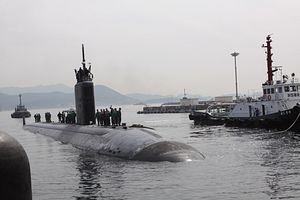The U.S. Navy Los Angeles-class attack submarine (SSN 770) USS Tucson made a port call at U.S. naval base Chinhae, located on the southeast tip of the Korean peninsula, on October 7 as part of its deployment to the Indo-Asia-Pacific region, U.S. Pacific Command announced in a statement on October 10.
Armed with 12 vertical launch tubes for Tomahawk cruise missiles and four torpedo tubes, the “Tucson is one of the stealthiest and most advanced submarines in the world,” according to the U.S. Navy. “Its stealth, endurance, mobility and responsiveness make Tucson a formidable force in multiple mission roles,” the service states.
The USS Tucson, homeported out of Pearl Harbor, Hawaii is the 20th boat of the improved Los Angeles-class and can be deployed for a multitude of missions, including anti-submarine warfare, anti-surface ship warfare, surveillance and reconnaissance. The SSN can also be used for land-attack operations by launching long-range, all-weather, subsonic Tomahawk cruise missiles with a range of about 3,100 kilometers.
Improved Los Angeles-class SSNs feature more advanced electronics, sensors, and noise reduction technology than the original variant of the submarine class which first entered service in the 1970s.
The U.S. Navy operates 36 Los-Angeles-class SSNs. Three older Los-Angeles-class subs will be decommissioned the end of 2017. They will be replaced with Virginia-class nuclear attack submarines. (The U.S. Navy commissioned the 14th Virginia-class nuclear attack submarine USS Washington on October 7.)
The U.S. Navy plans to induct 48 Virginia-class SSNs.
“The Korean-American relationship is very important and our visit to Chinhae gives us the opportunity to strengthen the outstanding relationship that exists between the U.S. and the Republic of Korea,” said Commander Chad Hardt, the commanding officer of the USS Tucson.
Los Angeles-class submarines make periodic port calls in South Korea as part of the U.S. Navy’s forward presence. In June, the Navy Los-Angeles-class attack submarine USS Cheyenne made an official port call to the southeastern city of Busan. In April, an Ohio-class guided missile submarine (SSGN), the USS Michigan, also visited Busan.
U.S. President Donald Trump caused controversy in May of this year when he revealed in a phone conversation with Philippine President Rodrigo Duterte that the U.S. Navy has been operating two nuclear-powered submarines in the waters off the Korean Peninsula.
It is likely that he was referring to Los-Angeles class and Ohio-class submarines during the phone conversation. The controversy arose because the U.S. Navy does not publicly announce the movement of its submarines.
U.S. Pacific Command did not elaborate when the USS Tucson will depart the Korean Peninsula. It is also unclear whether the submarine will engage in any naval drills with the Republic of Korea (ROK) Navy.
































